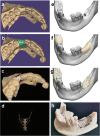Titanium mesh for bone augmentation in oral implantology: current application and progress
- PMID: 33380722
- PMCID: PMC7773733
- DOI: 10.1038/s41368-020-00107-z
Titanium mesh for bone augmentation in oral implantology: current application and progress
Abstract
Guided bone regeneration (GBR) is an effective and simple method for bone augmentation, which is often used to reconstruct the alveolar ridge when the bone defect occurs in the implant area. Titanium mesh has expanded the indications of GBR technology due to its excellent mechanical properties and biocompatibility, so that the GBR technology can be used to repair alveolar ridges with larger bone defects, and can obtain excellent and stable bone augmentation results. Currently, GBR with titanium mesh has various clinical applications, including different clinical procedures. Bone graft materials, titanium mesh covering methods, and titanium mesh fixing methods are also optional. Moreover, the research of GBR with titanium mesh has led to multifarious progresses in digitalization and material modification. This article reviews the properties of titanium mesh and the difference of titanium mesh with other barrier membranes; the current clinical application of titanium mesh in bone augmentation; common complications and management and prevention methods in the application of titanium mesh; and research progress of titanium mesh in digitization and material modification. Hoping to provide a reference for further improvement of titanium mesh in clinical application and related research of titanium mesh.
Conflict of interest statement
The authors declare no competing interests.
Figures


References
Publication types
MeSH terms
Substances
LinkOut - more resources
Full Text Sources
Other Literature Sources

